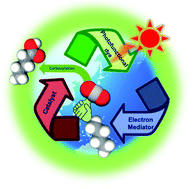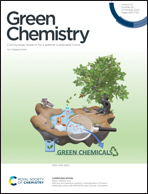Recent advances in light-driven C–H bond activation and building C–C bonds with CO2 as a feedstock for carbon capture and utilization technology
Abstract
CO2 is a representative greenhouse gas (GHG), and the Paris Agreement adopted by consensus on 12 December 2015 mandates worldwide reduction of CO2 emissions by 80% until the end of 2050 relative to that of 2013. In order to achieve a significant reduction in CO2, it is necessary to establish not only CO2 capture and storage (CCS), but also a wide range of technologies such as CO2 conversion to alcohol fuels such as methanol, utilization as chemical raw materials, and so on (CO2 capture and utilization CCU). The establishment of utilization technology aimed at reducing CO2 will contribute to “7. Use of renewable feedstocks” and “9. Catalyst” from the 12 principles of green chemistry. CO2 utilization technology can be divided into two categories: multi-electron reduction with multiple protons and binding to organic molecules. In the former case, CO, formic acid, and methanol are produced, so no extension of the carbon number of the target product is observed. In the latter case, CO2 is bonded to the organic molecule as a carboxyl group, so that a C–C bond can be newly built. In other words, with the latter technology, it becomes possible to fix CO2 to organic molecules and create new functional materials. For example, natural photosynthesis skilfully utilizes sunlight as a renewable energy and enzyme catalysts to synthesize glucose from CO2 and water as a raw material. In other words, CCU technology based on mimicking natural photosynthesis contributes to the above principles of green chemistry. To establish this technology, a catalyst that promotes the binding of CO2 to organic molecules is an essential factor. In other words, it is necessary to develop a catalyst for activating C–H bonds in organic molecules and promoting C–C bond formation with CO2. In this review, molecular and enzyme-based catalysts for C–H bond activation and building C–C bonds with CO2 applicable to light-driven CCU using a photoredox system are introduced. Moreover, light-driven C–H bond activation and building C–C bonds with CO2 using various catalysts and photofunctional materials are also introduced. The reaction yield and selectivity of both systems for C–H bond activation and building C–C bonds with CO2 are also discussed. Finally, we discussed the problems of the light-driven C–H bond activation and building C–C bonds with CO2 and mentioned some areas for improvement in the future. We also discussed the outline of the life cycle assessment (LCA) of a typical system for light-driven C–H bond activation and building C–C bonds with CO2.



 Please wait while we load your content...
Please wait while we load your content...